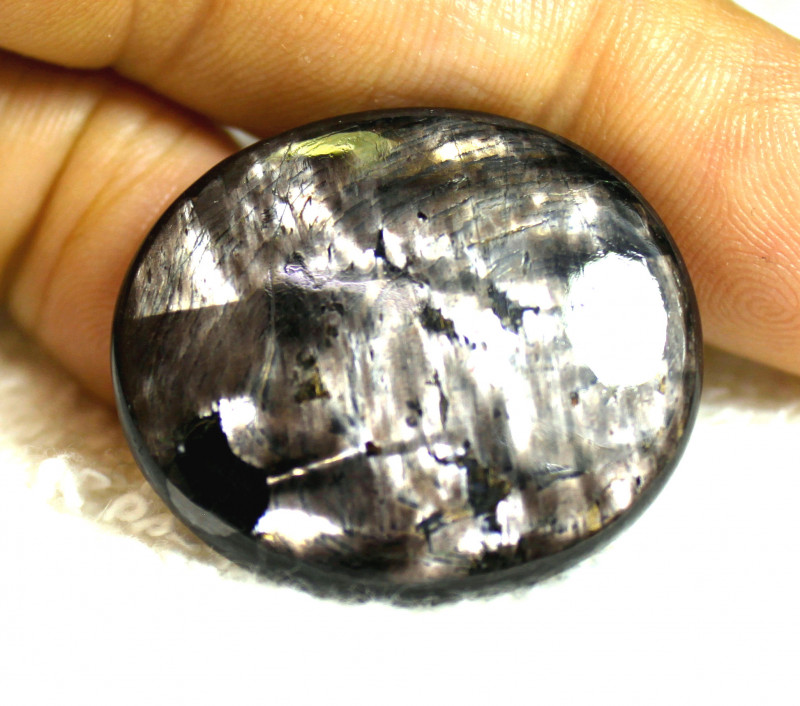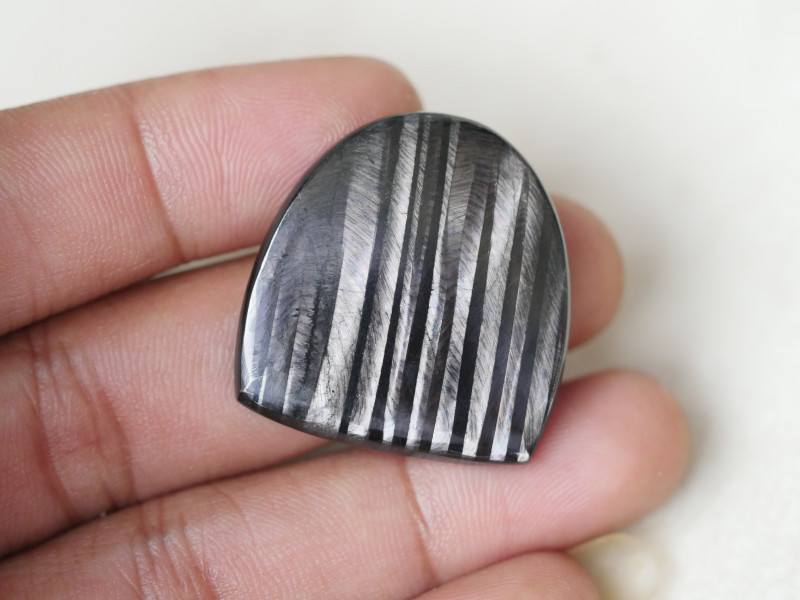
Hypersthene Gemstone: Properties, Meanings, Value & More
 Hypersthene is a common, dark gemstone with earthy brown, gray, or green shades. Though the term “hypersthene” isn’t universally accepted, this stone is popular among crystal healers. The mineral may come from the Earth or travel here on meteorites!
Hypersthene is a common, dark gemstone with earthy brown, gray, or green shades. Though the term “hypersthene” isn’t universally accepted, this stone is popular among crystal healers. The mineral may come from the Earth or travel here on meteorites!
Is hypersthene a lucky stone? Absolutely! Many spiritual practitioners carry hypersthene for luck and protection.
What about hypersthene’s mineral traits and healing properties? We’ll get into all those details and more as we cover everything about hypersthene gemstones that you need to know!

About Hypersthene Stone
The semi-precious gemstone hypersthene is a common mineral, though it’s not often found in faceted gemstones, making these pieces a rare delight.
Hypersthene usually has a silver, coppery, or red sheen that appears almost iridescent and is actually a form of asterism — the optical effect of parallel inclusions reflecting a multi-rayed “star” of light on the stone’s surface.
Hypersthene also has a velvety look combined with its holographic shimmer, leading to the nickname “velvet labradorite.”
While hypersthene and labradorite are completely different stones, they can be found in the same rocks. Sometimes stones are cut from a matrix of labradorite and hypersthene, creating one-of-a-kind specimens.
Astrologically, hypersthene zodiac stones grace all three fire signs (Aries, Leo, and Sagittarius) along with the water signs Cancer and Pisces.
As a mineral, what are the diagnostic characteristics of hypersthene?
Hypersthene Specifications & Characteristics
The mineral hypersthene is an orthopyroxene with the formula (Mg,Fe)2Si2O6 or (Mg,Fe)SiO3. It’s composed of magnesium, iron, and silica. The mineral looks similar to hornblende
Hypersthene forms a series with enstatite — (Mg)SiO3 — on one end and ferrosilite — (Fe)SiO3 — on the other, with hypersthene in the middle.
However, many geologists don’t use the term “hypersthene” at all, but rather identify these minerals as either ferrosilite or enstatite. In fact, the International Mineralogical Association (IMA) discredited the term “hypersthene.” Instead, they may call it “enstatite” or “ferroan enstatite.”
You may know that bronzite is an iron-bearing enstatite variety. Both hypersthene and bronzite are in the pyroxene family, and bronze-colored hypersthene stones with a near-metallic luster may be categorized as bronzite.
Well-formed crystals of hypersthene (small and prismatic) are a rare occurrence, as the mineral usually occurs as foliated, stocky masses.
Here’s the rest of hypersthene’s mineral data:
Mohs hardness: 5-6
Color: Brown, green, reddish-brown, orange-brown, red-orange, gray, grayish-black, green
Crystal structure: Orthorhombic
Luster: Vitreous (glassy) to pearly, sometimes metallic
Transparency: Transparent to opaque
Refractive index: 1.66-1.77
Density: 3.3-3.9
Cleavage: Perfect on [100] and [010]
Fracture: Uneven
Streak: Grayish-white or greenish
Luminescence: None
Pleochroism: Present and strong in blue-green and brownish-red
Ready to move on from mineral traits and into symbolism? Let’s go!

Hypersthene Stone Meaning & History
Hypersthene is nicknamed the “Golden Luck Stone” and “Stone of Magic” in the spiritual community. The crystal symbolizes resilience, self-love, and fulfillment. It’s also believed to be a particularly powerful protective talisman.
There’s also some interesting folklore associated with hypersthene from indigenous North American legends.
Among Squamish natives, the stone’s black hue and shimmering appearance were believed to originate when it was struck by lightning from a thunderbird. Thunderbirds are mythological spirits inside birds that are believed to send lightning from their beaks and flap their wings to create thunder.
Additionally, the Garibaldi Belt mountains where Squamish peoples found hypersthene stones were held as sacred. Geologically, many magnetic, iron-rich stones like hypersthene are found around these mountains.
History
First off, what does “hypersthene” mean? The name comes from the Greek terms hyper for “above” and stonos for “strength” or “power.”
The name most likely references hypersthene’s higher hardness compared to the amphibole mineral hornblende. But hypersthene isn’t related to hornblende, so what’s the deal?
Well, hypersthene’s first mention in mineralogical literature appeared within French mineralogist René Just Haüy’s Traité de Minéralogie in 1801. The studied samples came from Labrador, Canada, the famous first source of labradorite.
However, German geologist Abraham Gottlob Werner had also studied the stone and named it “paulite,” after the St. Paul island in Labrador.
Because no other deposits had yet been discovered and Haüy believed hypersthene was an amphibole mineral, he dubbed it “labradorite hornblende.”
The name “hypersthene” came from Haüy in 1804 when he realized it was a new mineral species. Eventually, more deposits would be uncovered outside of Canada.
Shifting back to the metaphysical side, what is hypersthene crystal good for in crystal healing?

Hypersthene Healing Properties
Like all gemstones, hypersthene’s internal vibrations and coloring influences its powers as a healing stone. Hypersthene with predominantly brown hues joins other brown gemstones in offering benefits like grounding and increased motivation.
On the other hand, green hypersthene stones evoke the heart-healing and fortune-bringing benefits of green gems.
Getting more specific, what is hypersthene used for in physical, emotional, and chakra healing?
Physical Healing
The purported physical benefits of hypersthene include treating:
Anemia and other blood disorders
Intestinal infections
Pain in the shoulders, neck, and muscles overall
Fatigue
Emotional Healing
Emotionally, hypersthene stone benefits are said to include boosting confidence while mitigating impulsivity and nurturing inner peace, especially when used during meditation.
Crystal healers recommend hypersthene crystals for providing protection from negativity. It’s also believed to bring emotional strength and help you shut out excess mental chatter to focus on getting done what you need to finish.
Chakra Healing
Chakra stones are used for opening a specific energy center (chakra) in the body to resolve the negative symptoms associated with that chakra being blocked. Hypersthene chakra stones can work on almost every chakra, but they’re particularly helpful for the root (or base) chakra.
The root chakra is your fundamental source for basic needs like stability, safety, and connection. When it’s blocked, feelings of uncertainty, anxiety, and detachment from others arise. Opening it with hypersthene replaces those feelings with grounding and comfort.

Hypersthene Gemstone Properties
When valuing hypersthene as a gemstone, the key categories to consider are its color, cut, transparency, and clarity.
Color
Hypersthene’s color most likely comes from its iron content, which usually makes up about 50 percent of the stone’s composition. The varying levels of iron and magnesium can lead to the different colors you’ll find hypersthene displaying.
Green stones are usually dark and streaked with lines of gray and pale green. The silver, copper, or red schiller is the result of broad, flat inclusions of goethite or hematite.
Richer, more saturated hues are more valuable, along with bright, velvety schiller.
Cut
Hypersthene crystals that are high enough quality to be faceted are rare, making them highly valuable. These are usually orange to brown hues.
Most hypersthene stones become cabochons, though gem cutters may also create hypersthene beads, carvings, or tumbled stones.
Clarity & Transparency
Hypersthene isn’t transparent enough to receive a colored gemstone clarity grade, but its transparency is a factor in its value. Stones with greater translucence are more valuable than opaque stones.
Since clarity measures visible inclusions, it’s important to note that hypersthene may contain various inclusions. Some, like the hematite or goethite inclusions that cause its schiller, increase the value. Other inclusions, like growth tubes, may decrease the value.
Inclusions sneak into the stone during formation, which brings us to hypersthene’s formation process.

Hypersthene Formation & Sources
Hypersthene forms inside rocks when high pressure and temperature levels allow the iron, magnesium, and silica to merge together and harden into the stone.
In geological environments, hypersthene is usually found inside igneous rocks like norite, though it may be found in metamorphic rocks. Fascinatingly, hypersthene is also a space gemstone, found in iron and stony meteorites.
Mining Locations
Where can I find hypersthene? The best gem-quality specimens come from Canada, plus the US states of New Jersey and California.
Additional hypersthene sources include:
Australia
Brazil
France
Germany
Greenland
India
Iran
Italy
Japan
Mexico
UK
Russia
Sri Lanka
Sweden
Tanzania
USA (Arizona)
Onto the main question on buyers’ minds: how much does hypersthene cost?

Hypersthene Price & Value
Hypersthene prices range significantly based on the seller and type of item. Cabochons are very affordable, fetching only $0.10-$2.50 per carat.
Jewelry has a broader price range, with many options falling in the pricier category.
Pendants range from $20 to $200, though many options are under $60. Beaded bracelets and necklaces are $250 to $400. Hypersthene rings are usually $175 to $300.
Before we wrap up, it’s important to know about caring for your gemstones.
Hypersthene Care and Maintenance
Hypersthene stones and jewelry require gentle care because the perfect cleavage means sharp blows could easily break the stone. We recommend getting jewelry with protective settings to help prevent breakage.
To clean hypersthene, simply wipe it carefully with a damp, clean, and soft cloth that’s lint-free. Then, allow the stone to air-dry.
Store hypersthene separately from other gems to avoid scratches. Avoid wearing it during strenuous activities like exercise, gardening, or cleaning.
Hypnotized by Hypersthene?
Whether you call it “hypersthene” or not, this dark gem has much more inside than you may think at first glance. Inside the brown or black exterior is a shimmer of gold, reflecting its confidence-boosting properties that remind us to find the gold inside ourselves and let it shine!
Search the Gemstone Encyclopedia
Related Auctions
Related Articles
Originally the Birthstones or gemstones were associated with a zodiac sign or the month of a individuals birth. Find out what your stone is and view the stones we have for sale
8th Feb 2021
There are dozens of quartz and chalcedony gems with various colors and patterns. Learn all about quartz properties and every type of quartz, from amethyst and agate to plasma and phantom quartz!
15th Oct 2020
Hackmanite is a pink to violet sodalite gem known for its unique color-change and luminescence. Learn why hackmanite is special, from its rare qualities to the types of hackmanite jewelry available.
28th Mar 2018
Latest Articles
Friedelite is an uncommon pink, red, or brown manganese silicate mineral best known from New Jersey and South Africa. Learn the prices, properties, uses, and history of friedelite gemstones.
23rd Dec 2024
Shortite is a rare mineral and rarer gemstone, usually found as colorless or yellow wedge-shaped crystals. Learn the value, history, and properties of shortite in this guide!
9th Dec 2024
Senarmontite is an uncommon antimony mineral mostly used industrially but occasionally collected as rare gems or pearly crystals. Find out all of the traits, uses, prices, and history of senarmontite.
27th Nov 2024
Article Categories
How To's is where you will find helpful articles from gem Rock Auctions on how to cut gemstones, select gemstones and buy gemstones.
9 Articles




